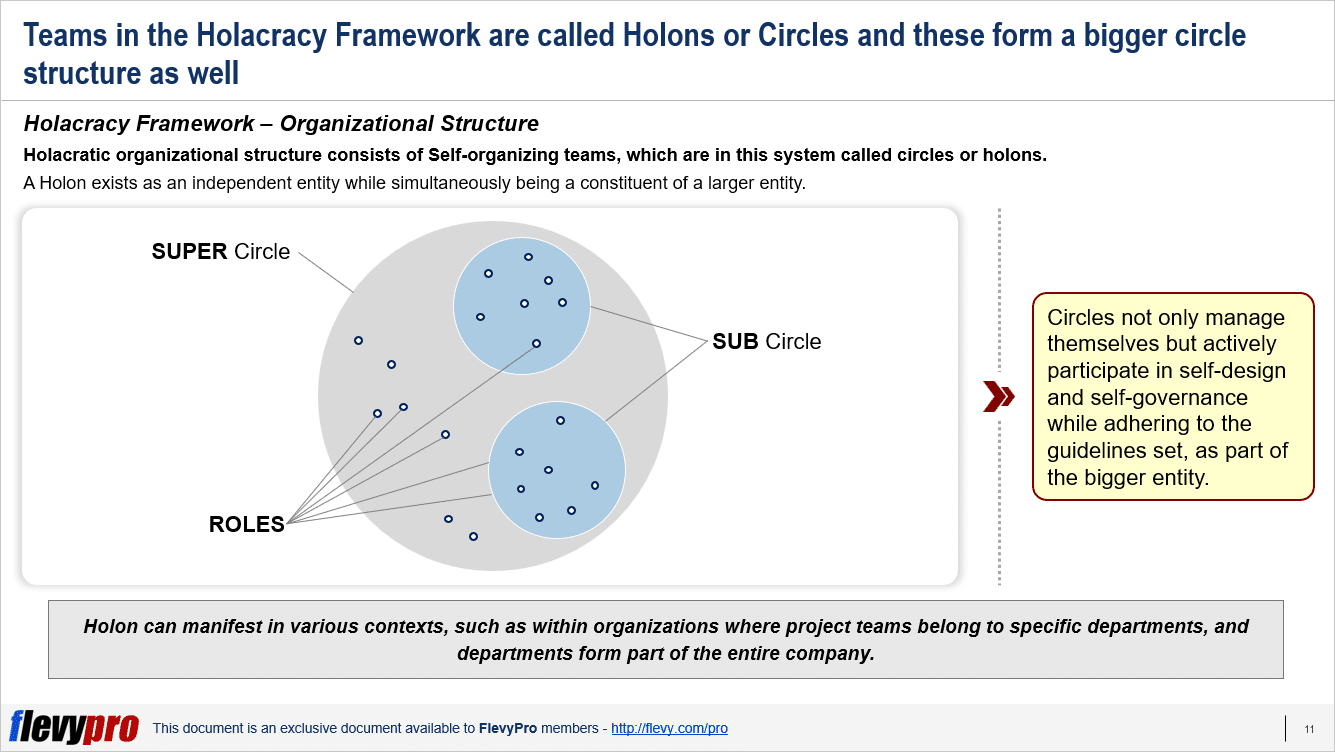Editor's Note: Take a look at our featured best practice, Matrix Organization: Matrix Management 2.0 (26-slide PowerPoint presentation). Matrix Management 2.0 is a state-of-the art integrated Management System for matrix organizations. It is designed to improve how companies lead, manage, and work in a two-dimensional matrix. The Matrix Management 2.0 (MM 2.0) shifts the focus from the vertical dimension to the horizontal. [read more]
The Holacracy Framework
* * * *
The concept of self-organization emerged as a response to the limitations and inefficiencies of traditional hierarchical organizations. Organizations recognized the need for a more flexible and adaptive approach to harness the collective intelligence and creativity of their employees.
Self-organization refers to a decentralized approach where Decision making authority is distributed among teams and individuals within an organization. Through self-organization, teams can adapt and respond more effectively to complex and changing circumstances.
Self-organization models commonly exhibit the following 3 shared characteristics.
- Teams are the structures.
- Teams design and govern themselves.
- Leadership is contextual.
The combination of the 3 results in an organization that prioritizes responsiveness to the demands of the work itself, rather than the directives of any influential individual.
The concept of self-management started somewhere in the 1960s with self-managed teams. The concept evolved into adhocracy in the 1980s and then in the 1990s to what some called “the networked firm.” Most recently, open-source, Agile methodologies, and the sharing economy have shaped participatory structures, including podularity, Holacracy, and customized self-organization approaches.
Different iterations of self-organization have emerged, but the most renowned and comprehensive system among them is Holacracy. Holacracy surpasses conventional norms of organizing in every aspect. Holacracy’s level of formality contributes to its relative ease of scrutiny and analysis, particularly because of its broader adoption and implementation compared to other organizational designs.
Holacratic organizational structure consists of self-organizing teams, which are in this system called circles or holons. A Holon exists as an independent entity while simultaneously being a constituent of a larger entity.
Circles not only manage themselves but actively participate in self-design and self-governance while adhering to the guidelines set, as part of the bigger entity.
Holacracy stands out because of its exceptionally flexible structure, high level of adaptability, constant engagement with all stakeholders, and strong tolerance for uncertainty. Another defining feature of Holacracy is its systematic approach to business, promoting extensive employee involvement in all aspects of the organization.
Holacratic organizations agree upon a constitution—an evolving document—delineating the rules by which circles are formed, altered, and abolished. The constitution specifies roles, limits, and interactions among circles rather than dictating methods for task completion.
Circles not only manage themselves but actively participate in self-design and self-governance while adhering to the guidelines set in the constitution.
A “lead link,” who is also in charge of connecting a circle to the larger circles it is a part of, reassigns roles in a holacratic organization.
Holacracy can be characterized as organizing the enterprise in a way that prioritizes the tasks at hand rather than the individuals performing them. While carrying out work, an individual may be assigned multiple roles, leading them to participate concurrently in a greater number of circles or holons.
Every role entails a specific degree of responsibility and authority, ensuring that each employee has a clear understanding of their expected duties and obligations. In cases where the responsibilities associated with a particular role exceed an individual’s capabilities, the role can be subdivided into multiple smaller roles.
Contrary to traditional hierarchical structures, where management follows a top-down system, Holacracy incorporates management at every level of the organization. Holacracy encourages peer collaboration, granting everyone the right to participate. When any team member identifies a discrepancy between the current and desired state, a meeting is called involving all employees to collectively address the issue.
The Holacracy Framework offers several potential benefits to organizations embracing the model, while at the same time it has received its fair share of criticism, and is not without challenges.
The Holacracy management system is being used by several companies, e.g., Zappos, Morning Star, and W.L. Gore being some of them.
Interested in learning more about Holacracy Framework? You can download an editable PowerPoint presentation on Holacracy Framework here on the Flevy documents marketplace.
Do You Find Value in This Framework?
You can download in-depth presentations on this and hundreds of similar business frameworks from the FlevyPro Library. FlevyPro is trusted and utilized by 1000s of management consultants and corporate executives.
For even more best practices available on Flevy, have a look at our top 100 lists:

Readers of This Article Are Interested in These Resources

|
|
32-slide PowerPoint presentation
|
|
18-page PDF document
| |||
About Mark Bridges
Mark Bridges is a Senior Director of Strategy at Flevy. Flevy is your go-to resource for best practices in business management, covering management topics from Strategic Planning to Operational Excellence to Digital Transformation (view full list here). Learn how the Fortune 100 and global consulting firms do it. Improve the growth and efficiency of your organization by leveraging Flevy's library of best practice methodologies and templates. Prior to Flevy, Mark worked as an Associate at McKinsey & Co. and holds an MBA from the Booth School of Business at the University of Chicago. You can connect with Mark on LinkedIn here.
Top 9 Recommended Documents on Organizational Structure
» View more resources Organizational Structure here.
» View the Top 100 Best Practices on Flevy.















